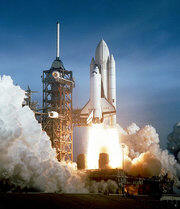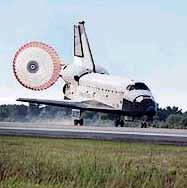|
   
> History
> Space Craft
> Unmanned Space Programs
> Animals in Space
> Human in Space
> Human in Moon
> Manned Space Programs
> Space Station
> Voyager 1
> Voyager 2
> Hubble Space Telescope
> Recent & Future Developments
       
|
Spacecraft that do not
have to carry human beings can be of a great variety of sizes, from a few
centimetres to several metres in diameter, and of many shapes, depending
on the purposes for which they are designed. Spacecraft that do not carry
a crew have radio-transmitting equipment, both to relay information back
to Earth and to signal the position of the spacecraft.
Manned spacecraft must fulfil more exacting requirements than unmanned
vehicles because of the needs of the human occupants. A manned space
vehicle is designed to provide air for the astronauts, food and water,
navigation and guidance equipment, seating and sleeping accommodation, and
communication equipment, so that the astronauts can send and receive
information. A distinctive feature of manned spacecraft is the heat shield
that protects the vehicle as it re-enters the atmosphere.
Propulsion
The rocket engines that launch and propel spacecraft are
of two main types: solid-propellant roc kets,
which use chemicals that burn in a fashion similar to gunpowder, and
liquid-propellant rockets, which use liquid fuels and oxidizers carried in
separate tanks. Most of the rockets that have launched American spacecraft
have had several separate rocket stages; each stage is separately powered
with its own fuel. After the fuel in each stage has been consumed, the
empty stage drops away from the spacecraft. kets,
which use chemicals that burn in a fashion similar to gunpowder, and
liquid-propellant rockets, which use liquid fuels and oxidizers carried in
separate tanks. Most of the rockets that have launched American spacecraft
have had several separate rocket stages; each stage is separately powered
with its own fuel. After the fuel in each stage has been consumed, the
empty stage drops away from the spacecraft.
Because the technology to build space-launch vehicles is closely akin to
that for long-range ballistic missiles, the United States and the USSR
were the only two countries that had the ability to launch satellites from
1957 to 1965. In subsequent years France, Japan, India, and China launched
Earth satellites of ever-increasing sophistication, and in May 1984 the
13-member European Space Agency (ESA) began its own launch programme from
a space centre at Kourou in French Guiana, on the Atlantic coast of South
America. The United States and the USSR, however, remained the only
nations with launch vehicles capable of placing in orbit payloads of many
tonnes—the prerequisite for manned space flight. [Top]
Launching and Re-entry
A space vehicle is launched from a specially
constructed launchpad, where the vehicle itself and the rocket that
propels it are set up and carefully inspected before launching. The
operation is supervised by engineers and technicians in the nearby control
centre. When all preparations are complete, the rocket engines are fired
and the rocket and spacecraft lift off.
 |
Space Shuttle Landing
A space shuttle glides back to Earth without
engine power and lands on a conventional aeroplane runway using a
parachute to slow its landing speed |
Re-entry poses the problem of slowing down a returning
spacecraft so that it lands on Earth without being destroyed by
aerodynamic heating. The space flights of the US Mercury, Gemini, and
Apollo programmes overcame the problem of re-entry by protecting the
leading surface of the returning capsule with a specially developed heat
shield, made of metals, plastics, and ceramic materials that melt and
vaporize during re-entry, thereby carrying off or dissipating the heat
without damage to the capsule or the astronauts. The heat shield developed
to protect the US space shuttle during re-entry consists of a covering of
ceramic tiles individually cemented to the shuttle’s hull. Before the
development of the space shuttle, which lands on a runway, all American manned spacecraft used the ocean to cushion
the impact of landing; the astronauts and the capsules were retrieved
quickly by helicopter and taken aboard waiting naval vessels. Soviet
cosmonauts have landed on solid ground in various sites in Siberia.
[Top] Orbiting the Earth
The orbit of a spacecraft around the Earth can be in the
shape of a circle or an ellipse. An artificial satellite in a circular
orbit travels at a constant speed. The higher the altitude, however, the
lower the speed relative to the surface of the Earth. Maintaining an
altitude of 35,800 km (22,300 mi) over the equator, a satellite is
geostationary. It moves in geosynchronous orbit, at exactly the same speed
as the Earth rotates on its axis, so that it remains in a fixed position
over some particular spot on the equator. Most communications satellites
are placed in such orbits.
In an elliptical orbit, the speed varies and is greatest at perigee
(minimum altitude) and least at apogee (maximum altitude). Elliptical
orbits can lie in any plane that passes through the Earth’s centre. A
polar orbit lies in a plane passing through the North and South Poles—that
is, it passes through the axis of rotation of the Earth. An equatorial
orbit is one that lies in a plane passing through the equator. The angle
between the orbital plane and the equatorial plane is called the
inclination of the orbit.
The Earth rotates once every 24 hours under a satellite in a polar orbit.
A polar-orbit weather satellite, carrying television and infrared cameras,
can thus observe meteorological conditions over the entire globe from pole
to pole in a single day. An orbit at another inclination covers a smaller
portion of the Earth, omitting areas around the poles.
As long as the orbit of an object keeps it in the vacuum of space, the
object will continue to orbit without propulsive power because there is no
frictional force to slow it down. If part or all of the orbit passes
through the atmosphere of the Earth, however, the body is slowed by
aerodynamic friction with the air. This causes the orbit to decay
gradually to lower and lower altitudes until the object has fully
re-entered the atmosphere and burns up, like a meteor. [Top]
Re-usable Space Craft
The first reusable spacecraft, the Space Shuttle, was
launched by the USA on the 20th anniversary of Yuri Gagarin's flight, on
April 12, 1981. During the Shuttle era, six orbiters were built, all of
which have flown in the atmosphere and five of which have flown in space.
The Enterprise was used only for approach and landing tests, launching
from the back of a Boeing 747 and gliding to deadstick landings at Edwards
AFB, California. The first Space Shuttle to fly into space was the
Columbia, followed by the Challenger, Discovery, Atlantis, and Endeavour.
The Endeavour was built to replace the Challenger when it was lost in
January 1986. The Columbia broke up during reentry in February 2003.
The first (and so far only) automatic reusable spacecraft was the Buran
(Snowstorm), launched by the USSR on November 15, 1988, although it made
only one flight. This spaceplane was designed for a crew and strongly
resembled the U.S. Space Shuttle, although its drop-off boosters used
liquid propellants and its main engines were located at the base of what
would be the external tank in the American Shuttle. Lack of funding,
complicated by the dissolution of the USSR, prevented any further flights
of Buran. [Back] [Top] [Next] |
 kets,
which use chemicals that burn in a fashion similar to gunpowder, and
liquid-propellant rockets, which use liquid fuels and oxidizers carried in
separate tanks. Most of the rockets that have launched American spacecraft
have had several separate rocket stages; each stage is separately powered
with its own fuel. After the fuel in each stage has been consumed, the
empty stage drops away from the spacecraft.
kets,
which use chemicals that burn in a fashion similar to gunpowder, and
liquid-propellant rockets, which use liquid fuels and oxidizers carried in
separate tanks. Most of the rockets that have launched American spacecraft
have had several separate rocket stages; each stage is separately powered
with its own fuel. After the fuel in each stage has been consumed, the
empty stage drops away from the spacecraft.